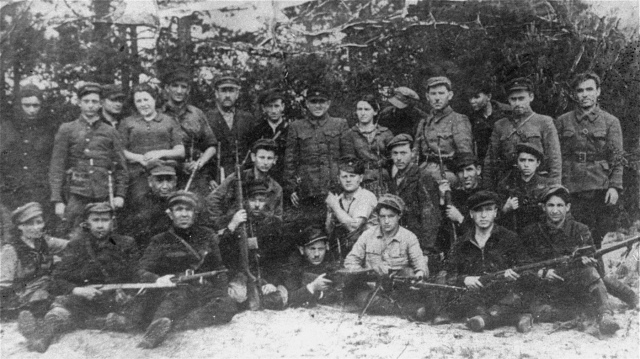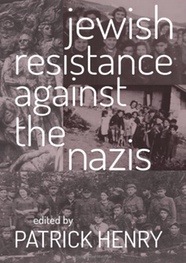The Myth of Jewish Passivity

A group of partisans from various fighting units including the Bielski group and escapees from the Mir Ghetto on guard duty at an airstrip in the Naliboki Forest. (USHMM, courtesy of Moshe Kaganovich)
As we approach the 70th anniversary of Nazi Germany’s defeat and the liberation of the camps, the continuing proliferation of studies and testimonies has given us an increasingly complete, complex understanding of the Holocaust. Yet one myth remains maddeningly persistent: that Jews went passively like sheep to slaughter. In actuality, voluminous historical documentation attests to the fact that Jews resisted whenever, wherever, and however it was possible. Sadly, the compelling evidence has done little to change a nearly universal misperception.
Built from stereotypes and simplifications, reinforced by the ever-looming iconography of emaciated victims staring out helplessly from behind concentration camp barbed wire, and perpetuated through cinema, the muddled supposition that Jews went like sheep to slaughter has hardened into received wisdom, petrifying into a rock-solid wall of common belief seemingly impervious to demolition no matter how much historical evidence can be marshaled against it.
 Now that evidence has been brought
together under one cover in Jewish Resistance
against the Nazis, edited
by Patrick Henry (The Catholic University of America Press, 2014. $39.95
paperback). As Henry explains, the volume aims to compile “the most convincing,
complete, and authoritative mass of evidence ever advanced in one volume in
opposition to the myth of Jewish passivity during the Holocaust.” The articles
chronicle Jewish resistance in every Nazi-occupied country; in the Jewish parts
of pre-Israel Palestine; in the forests, ghettos, and camps; children as
resisters, and music as resistance. Authors include leading historians from the
United States, Canada, Europe, and Israel.
Now that evidence has been brought
together under one cover in Jewish Resistance
against the Nazis, edited
by Patrick Henry (The Catholic University of America Press, 2014. $39.95
paperback). As Henry explains, the volume aims to compile “the most convincing,
complete, and authoritative mass of evidence ever advanced in one volume in
opposition to the myth of Jewish passivity during the Holocaust.” The articles
chronicle Jewish resistance in every Nazi-occupied country; in the Jewish parts
of pre-Israel Palestine; in the forests, ghettos, and camps; children as
resisters, and music as resistance. Authors include leading historians from the
United States, Canada, Europe, and Israel.
My contribution is “The Myth of Jewish Passivity,” which explores the origins and tenacious persistence of this pernicious myth.
The image dates back to the Hebrew Bible, where we read about a servant of the Lord who “was oppressed, though he humbled himself / And opened not his mouth; / As a lamb that is led to the slaughter, / And as a sheep that before her shearers is dumb; / Yea, he opened not his mouth” (Isaiah 53:7). That image is also positively presented in Psalm 44, Jewish morning prayers, and the Talmud. In none of these is it associated with humiliating passivity; rather, silence signifies the faith of people who do not forsake God in extremity and who die courageously, free from cowardly terror, for God’s holy name. Moreover, these texts feature cries to arouse God to act.
As Christianity developed, going to death like “sheep to slaughter” retained a positive connotation, though for different reasons. For Christians the phrase embodied the virtue of meekness and prefigured Christ’s submissive sacrifice of himself as lamb of God.
In World War II, “like sheep to slaughter” came from Abba Kovner, a resistance fighter from Vilna. On January 1, 1942, Kovner proclaimed: “We will not be led like sheep to slaughter. True we are weak and helpless, but the only response to the murders is revolt. Brethren, it is better to die fighting like free men than to live at the mercy of the murderers. Arise, Arise with last breath. Take Courage!” Kovner was not characterizing other Jews, but trying to inspire those alongside him to revolt. His words became twisted after the Holocaust, when their context was forgotten. The image had become distorted from stirring admiration for brave martyrdom to blaming victims contemptuously.
The perception of Jewish passivity was seared into the popular mind by footage of skeletal concentration camp prisoners, and the iconic photograph of a Warsaw ghetto boy surrendering with his arms raised. Images from Nazi propaganda films were recycled in post-war western documentaries without their sources identified. Those images reinforced centuries-old stereotypes of Jews as weak, passive, and feminine.
Popular culture provides continuing reinforcement. Schindler’s List stands as one example of a film that portrays Jews as helpless and in need of Christian rescue. The acclaimed 2011 film The Debt states the myth baldly. Nazi war criminal Doktor Vogel is kidnapped by Mossad agents. He says to one of his captors, “Why do you think it was so easy to exterminate you people? Your weakness. I saw it. Every day I saw it. … Why do you think it took only four soldiers to lead thousands to the gas chambers? Because not one of out of thousands had the courage to resist. Not one would sacrifice himself even when we took their children away. So I knew then that you people had no right to live. …” His words encapsulate the charge of Jewish passivity…and The Debt does nothing to debunk them.
One must acknowledge that in the 1960s the Jewish intellectuals Viktor Frankl, Bruno Bettelheim, Hannah Arendt, and Raul Hilberg accepted and wrote that Jewish resistance had been negligible, and even if unintentionally, they implied that Jews were therefore partly to blame for their own destruction. Their works reached mass audiences. Richard Rubenstein’s The Cunning of History (1975) endorsed Hilberg’s argument that a Jewish culture of submissiveness had aided the destruction.
Records chronicling resistance came to light slowly, but as they surfaced, a clearer picture of Jewish resistance emerged. Books about Jewish resistance had appeared in the 1940s and 1950s. K. Shabbetai’s As Sheep to Slaughter?: The Myth of Cowardice (1962), Yuri Suhl’s They Fought Back (1967), and a major conference on “Manifestations of Jewish Resistance” was at Yad Vashem in 1968 unleashed a floodtide. Since then, many volumes have chronicled aspects of resistance.
With historians having unearthed ample factual evidence to the contrary, we might well ask what accounts for the myth’s ongoing cultural reproduction and appeal. The difficulty of stripping out the deeply ingrained myth comes partly from its cultural roots, partly because it plays into Christian ideals of meekness as positive, partly because many people do not understand what was a complex historical situation, and partly because of the comforting reassurance it offers.
Film historian Judith Doneson suggested that “the weakness during World War II that found European Jewry in a situation of dependency for survival might still be preferred … by the Christian/gentile world.” Philosopher Emil Fackenheim discerned a lapse into escapism. Psychologist Eva Fogelman posits that by blaming the victim we avoid facing our own fears of helplessness; we also “exaggerate the importance of resistance because we want to believe that we have the ability to control our own fate.” Or that we would have acted more boldly.
Finally, perhaps a world that stood by while Jews were murdered exonerates itself by displacing and projecting its own passivity onto the very victims it failed to protect. Blaming presumed Jewish passivity for past mass slaughter of Jews confers comfort by diverting our attention from our own position as passive bystanders amid present genocides; after all, if it is the responsibility of Bosnian Muslims, Tutsis, Sudanese, or East Africans to resist, then we are not responsible for their deaths.
What if anything can be done to counter the appeal, and to hasten the demise, of the myth? As historian Yehuda Bauer cautions, we do not need a new mythology that romanticizes or hyperbolizes Jewish resistance. Rather, we need a more nuanced, balanced, accurate view of Jewish resistance to supplant the still-dominant paradigm. No model should sacrifice historical truth.
Educational outreach programs focusing on Jewish resistance—for students of all ages and the general public—may offer the best hope of cultivating a new understanding that will relegate the myth of Jewish passivity to the heap of discredited ideas from the past, so that the myth itself does not outlive the last survivor.